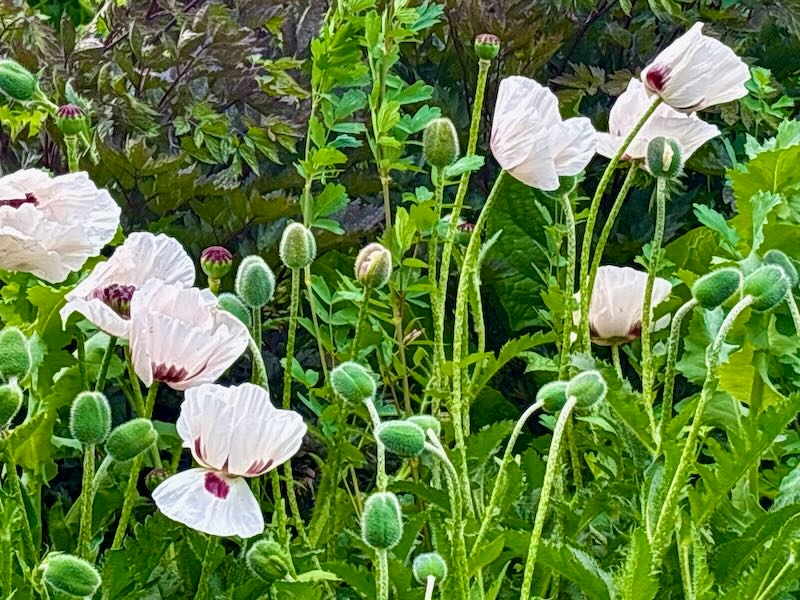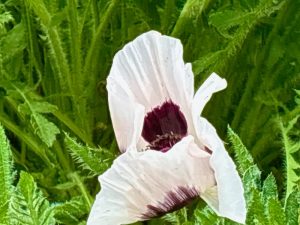Papaver orientale ‘Royal Wedding’: A Garden Showstopper with Stunning White Blooms
Papaver orientale ‘Royal Wedding’ is one of the most eye-catching Oriental Poppies you can grow. Belonging to the family Papaveraceae, this striking perennial offers a display of large, satiny, white flowers with a deep black eye and dark splotches at the base of each petal. Blooming from late spring to early summer, its cup-shaped blossoms appear almost like delicate crepe paper, stealing the spotlight in any sunny border. Whether planted in drifts or as a focal point in a mixed bed, this poppy creates a bold and unforgettable visual statement.
A Closer Look at Papaver orientale ‘Royal Wedding’
The flowers of Papaver orientale ‘Royal Wedding’ are nothing short of spectacular. Measuring 10–15 cm (4–6 inches) across, these pure white blooms are offset by an inky black center, creating a high-contrast appearance that instantly draws attention. Each flower rises on a sturdy, hairy stem above a clump of silvery-green, thistle-like foliage.
Mature plants reach about 75–90 cm (30–36 inches) in height and spread 45–60 cm (18–24 inches), forming tidy clumps that make them easy to incorporate into borders. After blooming, the plant produces ornamental seedpods, which add interest to the garden well into summer and can also be used in dried floral arrangements.
Growth Habit and Landscape Uses
Oriental Poppies like ‘Royal Wedding’ are clump-forming perennials with a moderate growth rate. They are best planted in sunny borders, cottage gardens, or rock gardens where their showy blooms can be appreciated. These poppies also work beautifully when interplanted with perennials that provide summer coverage after they go dormant.
In mixed borders, they pair especially well with plants like Gypsophila paniculata (Baby’s Breath), Perovskia atriplicifolia (Russian Sage), or Leucanthemum × superbum (Shasta Daisy). Such companions help fill in gaps left by the poppy’s summer dormancy and enhance its elegant white-and-black color scheme.
Flowering Season
Papaver orientale ‘Royal Wedding’ blooms in late spring to early summer, typically during May and June depending on climate. Its flowers provide a stunning transition between spring bulbs and the bright perennials of midsummer. After flowering, the plant enters a dormant period, with foliage dying back by mid-summer — a normal growth pattern for Oriental Poppies.
How to Grow Papaver orientale ‘Royal Wedding’
Light
Plant ‘Royal Wedding’ in full sun to ensure strong stems and vibrant blooms. A minimum of 6–8 hours of direct sunlight per day is ideal. In hotter climates, very light afternoon shade can help prolong flowering.
Soil
This poppy thrives in well-drained, fertile soils that are slightly alkaline to neutral. Avoid planting in areas with heavy, waterlogged soil. For clay-heavy gardens, amend the soil with compost or grit to improve drainage.
Watering
Once established, Oriental Poppies are relatively drought-tolerant. Water deeply and infrequently, allowing the soil to dry slightly between waterings. During the dormant period after flowering, reduce watering significantly.
Fertilizing
These plants are light feeders. Apply a slow-release balanced fertilizer in early spring or add compost around the base to provide a gentle nutrient boost. Over-fertilizing can lead to excessive foliage growth at the expense of blooms.
Mulching
Mulch lightly in winter to protect the crown, especially in colder regions. Use organic mulches like straw or shredded bark, but avoid covering the crown directly.
Pruning and Deadheading
Deadhead spent flowers promptly to extend the blooming season and reduce self-seeding. Cut stems back to just above the basal foliage. After the foliage dies back in midsummer, it can be trimmed away to tidy the garden.
Propagation
Papaver orientale ‘Royal Wedding’ can be propagated from seed or by dividing mature clumps in late summer or early fall. If starting from seed, be patient — it may take a couple of years for new plants to bloom. Self-seeding may occur, but these seedlings often produce variable flowers.
Pests and Diseases
This cultivar is resistant to deer and rabbits, making it a reliable choice for gardens with browsing wildlife. It is generally low-maintenance, though poorly drained soils can cause root rot. In wet weather, buds may blacken before opening, a sign of botrytis infection, which can be mitigated by improving air circulation and applying fungicides when necessary.
Environmental Tolerances
Papaver orientale ‘Royal Wedding’ grows best in USDA zones 3–7. It thrives in cooler climates with cold winters and drier summers but does not perform well in regions with high humidity and prolonged summer heat.
Design Tips for Papaver orientale ‘Royal Wedding’
Use ‘Royal Wedding’ to brighten the early summer border with its luminous white flowers. Combine it with deep purples or blues for a dramatic contrast, or pair with pastel-colored companions for a softer look. Since the foliage disappears in summer, plant it alongside late-emerging perennials like Salvia nemorosa, Nepeta, or ornamental grasses to disguise bare spots.
Final Thoughts
Papaver orientale ‘Royal Wedding’ is a perennial that delivers a powerful display with minimal effort. Its stunning crepe-paper blooms, low maintenance needs, and wildlife resistance make it an outstanding choice for sunny borders and cottage-style gardens. With thoughtful placement and a few complementary companion plants, this Oriental Poppy will become a highlight of your late spring garden.



